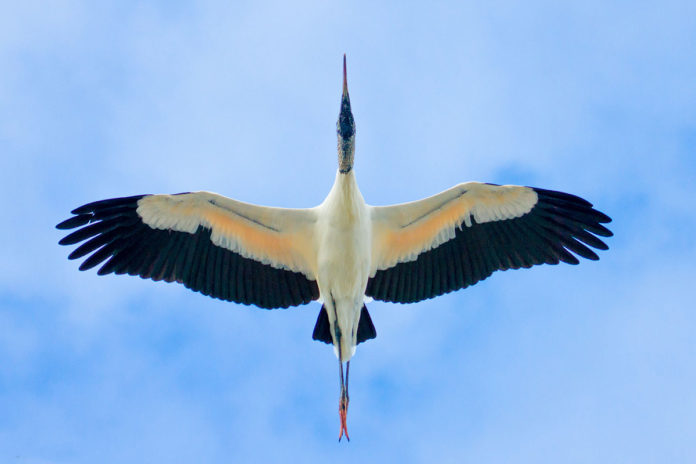I was up on Rockland Key, scanning around with my binoculars, somewhere between the highway, the cockfighting district and the roaring jets at NAS Key West, when I saw them – four big, white birds perched atop a small mangrove cluster, like candles on a cake.
And only one phrase came into my head: “plate of shrimp.”
I’m not exactly sure how, but during my high school and college years I, by casual estimate, managed to see the movie “Repo Man” 30 or 40 times. Which is a lot considering I don’t believe I ever actually put the movie on myself. It was always just there, usually playing from a friend’s or roommate’s well-worn VHS tape.
The movie starred Emilio Estevez (arguably his best work, though I’ve never seen “The Mighty Ducks”) and Harry Dean Stanton, and had cameos by a lot of musicians, including Michael Nesmith of the Monkees, the founding members of the Circle Jerks, and most unexpectedly, Jimmy Buffett of Jimmy Buffett fame. It was peak mid-’80s punk – cheaply cynical, wiseassed, borderline plotless, and funnier every time you watched it. It was so low-budget that director Alex Cox overspent on glow-in-the-dark paint for the ’64 Chevy Malibu in the final scene and was almost unable to complete the movie. (Cox went on to make the very successful Sid Vicious biopic “Sid and Nancy,” then to make the much less successful, and hardly watchable, “Straight to Hell” with Dennis Hopper, Grace Jones, Elvis Costello, Joe Strummer and the world’s greatest traditional-Celtic-music-inspired punk band the Pogues.)
During a pivotal scene, Estevez and a character named Miller are in a parking lot burning old clothes in a 50-gallon oil drum when Miller lays out one of his life philosophies.
“A lot of people don’t realize what’s really going on. They view life as a bunch of unconnected incidents and things. They don’t realize that there’s this, like, lattice of coincidence that lays on top of everything. Give you an example, show you what I mean: suppose you’re thinking about a plate of shrimp. Suddenly someone’ll say, like, “plate,” or “shrimp,” or “plate of shrimp” out of the blue, no explanation. No point in lookin’ for one, either. It’s all part of a cosmic unconsciousness,” he said.
For years afterwards, if any of my friends said “plate” or “shrimp,” or “plate of shrimp,” someone else would mention there’s no point looking for it. Because the lattice of coincidence is always with us.
At the Christmas Parade the other night, somewhere between Mayor Teri Johnston in her sporty Saturday Night Fever-ish pantsuit, the Conchettes riding the Conch Train, and the person from Overseas Media Group winging a pack of Dots – much preferable to Smartees – at my chest, I was having an in-depth conversation with someone about what a seminal and important film “Repo Man” was, at least to me in my youth.
Right before that conversation about “Repo Man,” though, I’d been talking birds with fishing guide Aaron Snell. He said he was a bit surprised the other day when he was driving down U.S. 1 near Big Coppitt and saw a small flock of wood storks circling overhead.
He said something like, they’re pretty cool, and I said something like, yeah, they are pretty cool. And then the marching band came.
Wood storks are mainland birds. Their scientific name is Mycteria americana, which roughly translates to “American big nose” on account of their big honking bill – though “honking” may not be the best adjective, as their voice is considered underdeveloped, coming off more like a grunt than anything. But the point is, they are America’s stork, the only one we have. (USA! USA!) Back in Audubon’s day, their range spread from Florida as far north as Alabama, Louisiana and Texas. Audubon said he saw flocks of thousands. In the 20th century, though, their population, largely due to plume hunting, habitat loss and changes in Florida’s hydrology, crashed and retracted mostly to central and south Florida. From 1984 to 2014 they were listed as a federal endangered species, and since 2014 have been listed as threatened, which is a lesser grade of protection, but still some protection.
In Audubon’s time they were officially known as the wood ibis, as they look something like an overgrown version of the more delicate and diminutive white ibis. They were also known more casually as the gourd head, flint head, iron head, flinched, and for reasons unclear, the preacher and the Colorado turkey.
The focus on their head is probably due to two things: that big honking bill, which can probe deep into the mud, clamp down and snatch things up as large as a baby alligator by feel, and also the fact that their head is pretty much featherless, thus drawing even more attention. Most wading birds, when you stare at them long enough, look a bit like dinosaurs, but wood storks look really, really like dinosaurs. Which is why, I believe, both Aaron and I thought they looked pretty cool.
I’ve seen wood storks in the Keys maybe once or twice in my life. They tend to come down here as day trippers, out of a lark, out seeking new shallow muddy ponds to snack in. I’ve seen enough of them on the mainland that I didn’t really consider going out to try and find them. And honestly, five minutes after talking to Aaron, I’d forgotten all about those birds.
But then I was on Rockland, and there they were, as if they’d been waiting for me, as if the lattice of coincidence and the cosmic unconsciousness needed to remind me of the way the world really worked.






















